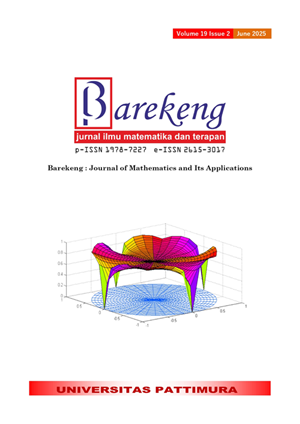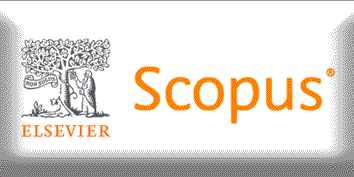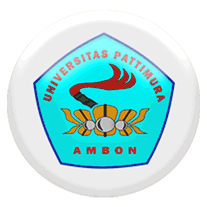MODELING AND FORECASTING THE TOTAL VOLUME OF GOODS TRANSPORTED BY RAIL IN INDONESIA USING SEASONAL AUTOREGRESSIVE INTEGRATED MOVING AVERAGE (SARIMA)
Abstract
Transportation has an important role in supporting the mobility of people in Indonesia. Trains are included in the most widely used transportation category because they are effective and efficient, not only transporting passengers, trains also have a role in the distribution of goods. This study aims to model and forecast total volume of goods transported through rail transportation in Indonesia using the Seasonal Autoregressive Integrated Moving Average (SARIMA) Method because the data has seasonal trend. The data used comes from the Central Statistics Agency (BPS) from January 2013 to April 2024. The results were obtained that the SARIMA (0,1,1)(0,1,1)12 model is the best model with a MAPE value of 0.96% which is included in the category of accurate model. In addition to being an additional insight, this research can also be a reference in the management of railway transportation considering the number of uses both passengers, the distribution of goods that continue to increase, and can be recommendation for other research that same topic with it.
Downloads
References
P. A. Wibowo, Ngaijan, A. S. Sumantri, and Supriyanto, “ANALYSIS OF INFLUENCING FACTORS IN THE SELECTION OF RAILWAYS AS A MODE OF TRANSPORTATION (STUDY ON TRAIN USERS. KAMANDAKA SEMARANG – PURWOKERTO ROUTE) PURNOMO,” J. Ekon. Bus. Manag., vol. 2, no. 3, pp. 361–378, 2023.
Central Statistics Agency, “NATIONAL TRANSPORTATION DEVELOPMENT MARCH 2024,” Central Statistics Agency, 2024.
S. Okyere, J. Yang, and C. A. Adams, “OPTIMIZING THE SUSTAINABLE MULTIMODAL FREIGHT TRANSPORT AND LOGISTICS SYSTEM BASED ON THE GENETIC ALGORITHM,” Sustainability, 2022.
N. Novitasari, E. Zukhronah, and S. S. Hndajani, “RECONCILIATION OF THE NUMBER OF GOODS THROUGH RAIL TRANSPORTATION IN INDONESIA USING SARIMA,” Sustainability, vol. 7, no. 1, 2021.
Nasir and Sukmawati, “ANALYSIS OF RESEARCH DATA QUANTITATIVE AND QUALITATIVE” Edumaspul Jurnal Pendidikan, vol. 7, no. 1, 2023.
F. Petropoulos et al., “FORECASTING: THEORY AND PRACTICE,” Int. J. Forecast., vol. 38, no. 3, pp. 705–871, 2022, doi: 10.1016/j.ijforecast.2021.11.001.
Z. Liu, Z. Zhu, J. Gao, and C. Xu, “FORECAST METHODS FOR TIME SERIES DATA : A SURVEY,” IEEE Xplore, vol. 9, pp. 91896–91912, 2021.
H. Setiawan and D. Novita, “ANALYSIS OF USER SATISFACTION OF THE KAI ACCESS APPLICATION AS A MEDIA FOR ORDERING TRAIN TICKETS USING THE EUCS METHOD,” J. Technol. Sist. Inf., vol. 2, no. 2, pp. 162–175, 2021.
I. Ardiansah, I. F. Adiarsa, S. H. Putri, and T. Pujianto, “APPLICATION OF TIME SERIES ANALYSIS TO ORGANIC PRODUCT SALES FORECASTING USING MOVING AVERAGE AND EXPONENTIAL SMOOTHING METHODS,” J. Tek. Pertan. Lampung (Journal Agric. Eng., vol. 10, no. 4, p. 548, 2021.
M. Xu, J. Li, and Y. Chen, “VARYING COEFFICIENT FUNCTIONAL AUTOREGRESSIVE MODEL WITH APPLICATION TO THE U . S . TREASURIES,” J. Multivar. Anal., vol. 159, pp. 168–183, 2017.
L. Martínez-Acosta, J. P. Medrano-Barboza, Á. López-Ramos, J. F. R. López, and Á. A. López-Lambraño, “SARIMA APPROACH TO GENERATING SYNTHETIC MONTHLY RAINFALL IN THE SINÚ RIVER WATERSHED IN COLOMBIA,” J. Atmos., vol. 11, no. 6, pp. 1–16, 2020.
T. H. Abebe, “TIME SERIES ANALYSIS OF MONTHLY AVERAGE TEMPERATURE AND RAINFALL USING SEASONAL ARIMA MODEL ( IN CASE OF AMBON),” Int. J. Theor. Appl. Math., vol. 6, no. 5, pp. 76–87, 2020.
Y. W. A. Nanlohy and S. B. Loklomin, “AUTOREGRESSIVE INTEGRATED MOVING AVERAGE (ARIMA) MODEL FOR FORECASTING INDONESIAN INFLATION,” Var. J. Stat. Its Appl., vol. 5, no. 2, pp. 201–208, 2023.
E. Vivas and H. Allende-cid, “A SYSTEMATIC REVIEW OF STATISTICAL AND MACHINE LEARNING METHODS FOR ELECTRICAL POWER FORECASTING WITH REPORTED MAPE SCORE,” Entropy, 2020.
B. Dhyani, M. Kumar, P. Verma, and A. Jain, “STOCK MARKET FORECASTING TECHNIQUE USING ARIMA MODEL,” Int. J. Recent Technol. Eng., vol. 8, no. 6, pp. 2694–2697, 2020.
Copyright (c) 2025 Idrus Syahzaqi, Sediono Sediono, Aurellia Calista Anggakusuma, Ezha Easyfa Wieldyanisa, Sabrina Salsa Oktavia

This work is licensed under a Creative Commons Attribution-ShareAlike 4.0 International License.
Authors who publish with this Journal agree to the following terms:
- Author retain copyright and grant the journal right of first publication with the work simultaneously licensed under a creative commons attribution license that allow others to share the work within an acknowledgement of the work’s authorship and initial publication of this journal.
- Authors are able to enter into separate, additional contractual arrangement for the non-exclusive distribution of the journal’s published version of the work (e.g. acknowledgement of its initial publication in this journal).
- Authors are permitted and encouraged to post their work online (e.g. in institutional repositories or on their websites) prior to and during the submission process, as it can lead to productive exchanges, as well as earlier and greater citation of published works.






1.gif)



